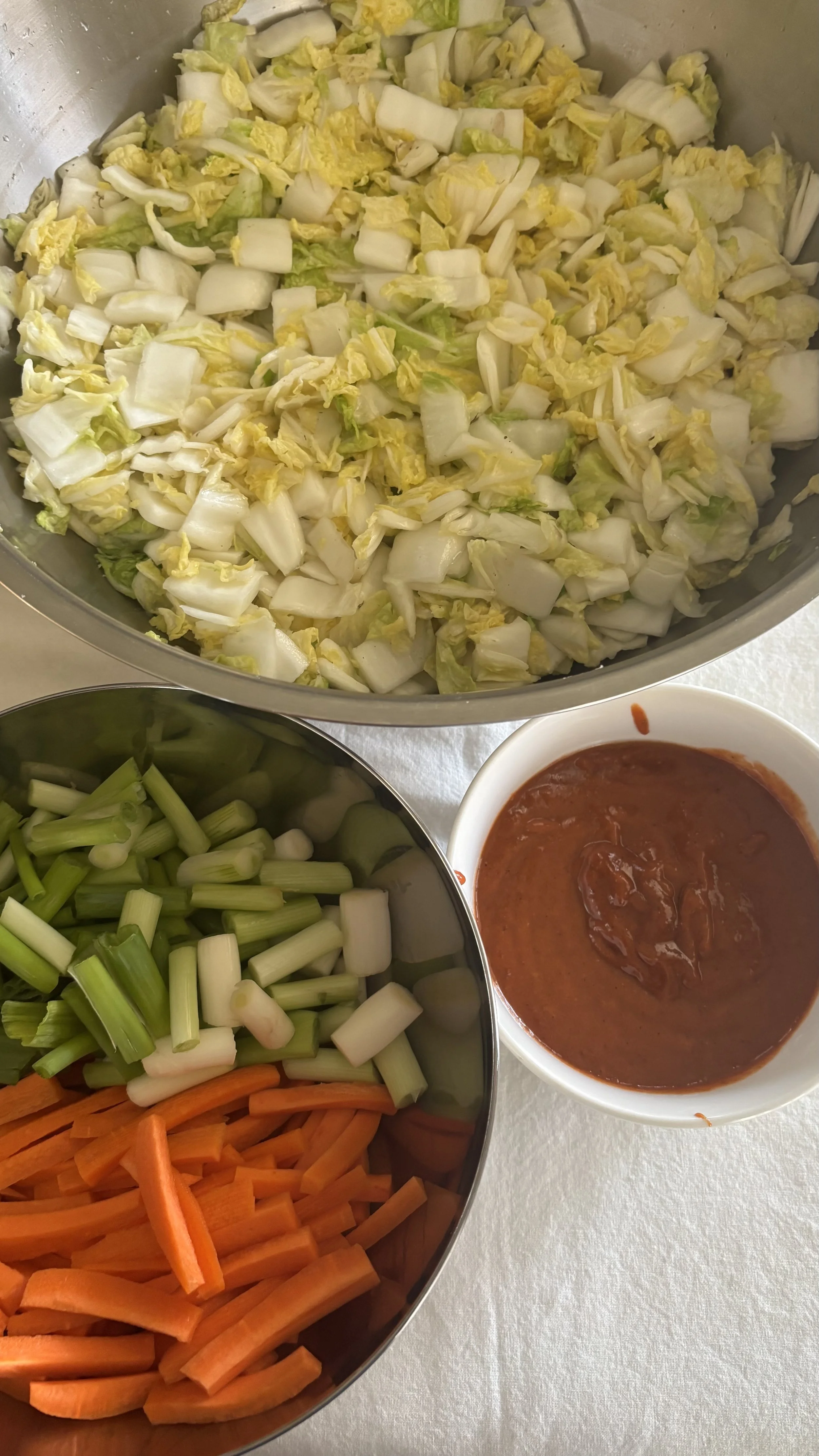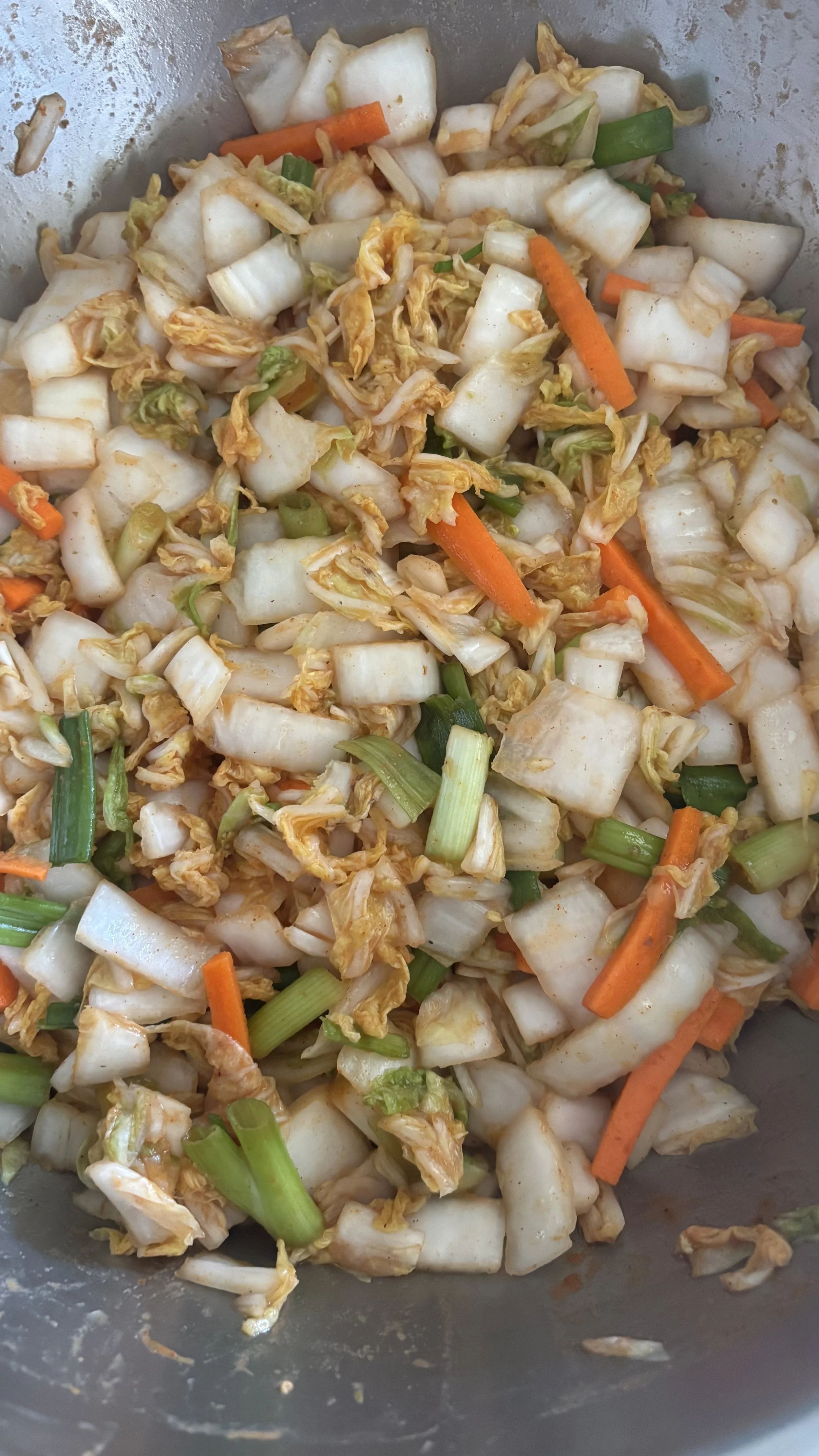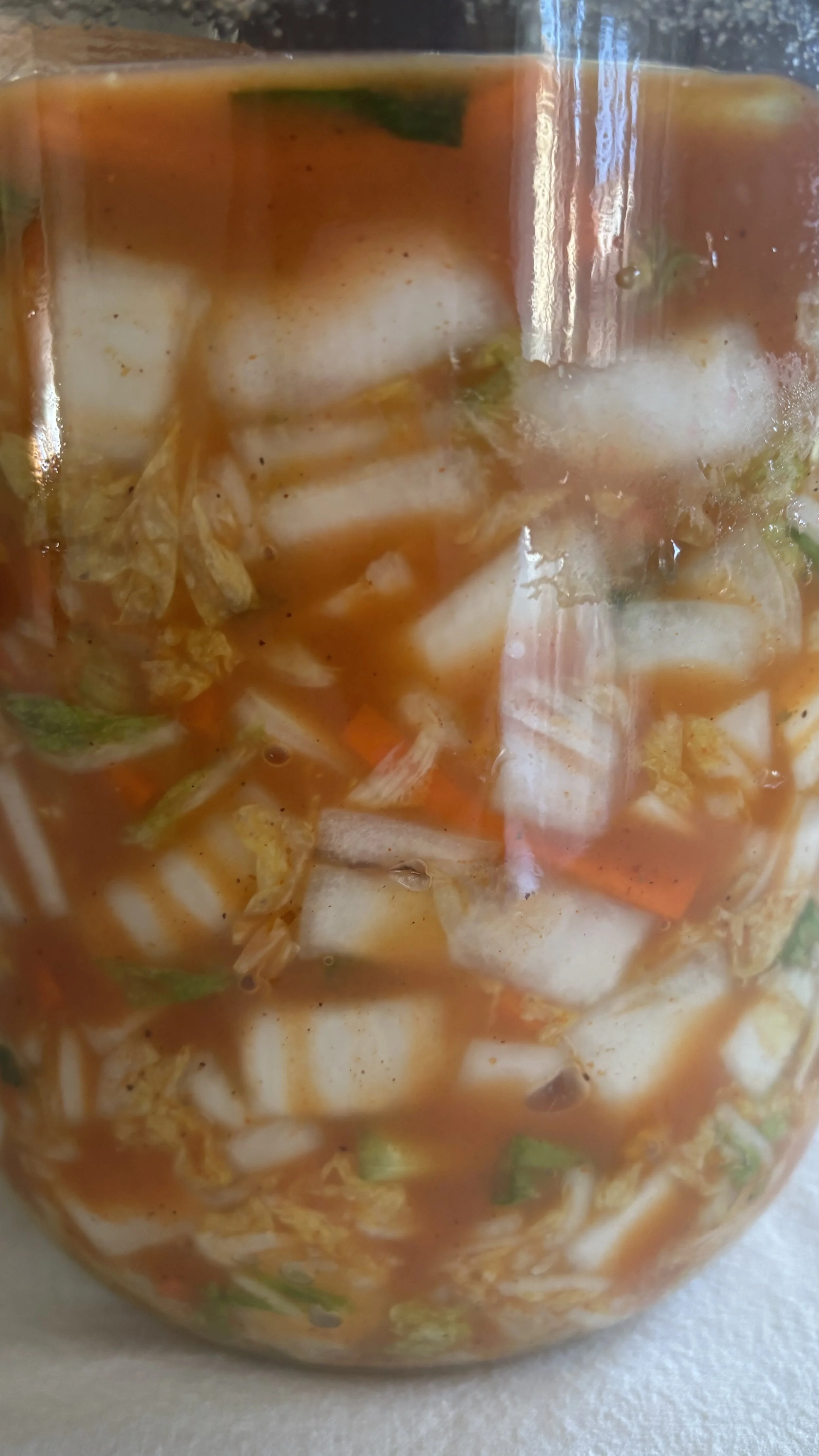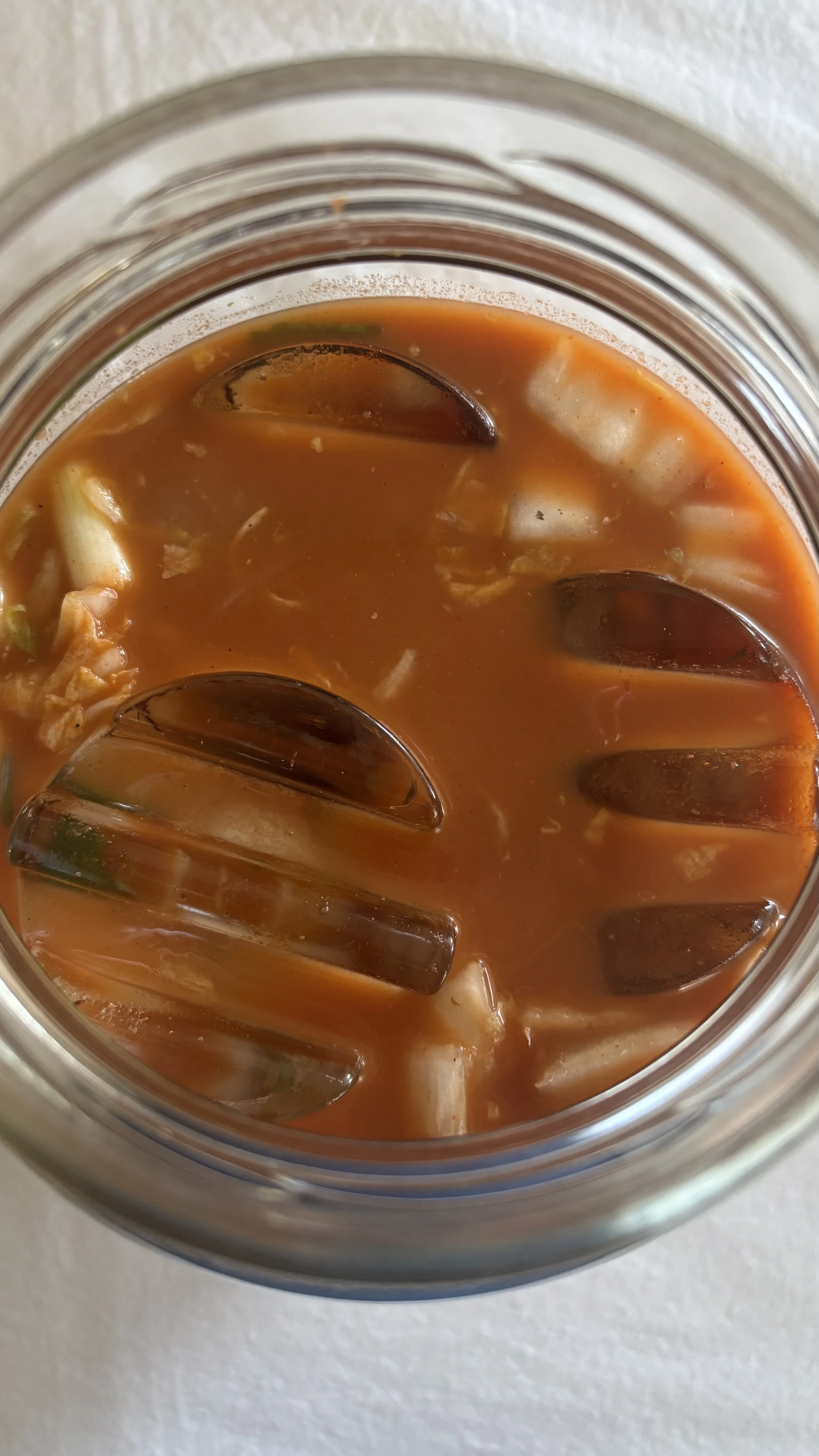Simple quick homemade kimchi
My favorite fermented cabbage, KIMCHI! If you’ve ever opened a jar of kimchi and been hit with that punchy, sour, spicy, fishy aroma—you know this fermented Korean staple is more than just a side dish.
Kimchi is alive with probiotics, enzymes, and gut-friendly goodness. But here’s something most people don’t realize: making it at home is not only easy, it’s also healthier and more customizable than many store-bought options.
Why Homemade Kimchi Beats Store-Bought? Walk into most food stores and you’ll find at least a few varieties of kimchi. But take a closer look at the labels: you might see gluten, MSG, preservatives, or even added sugars. Some commercial versions are pasteurized, which kills off beneficial bacteria, defeating the very reason we eat fermented foods in the first place.
By making your own, you control exactly what goes into your kimchi. That means:
No gluten (many brands use soy sauce or wheat-based thickeners)
No MSG or refined sugar
Only clean, real-food ingredients that support your gut, immune system, and hormones
Fermentation for Women’s Health - Kimchi isn’t just tasty—it’s deeply functional food, especially for women. The combination of raw vegetables, natural enzymes, probiotics, and anti-inflammatory spices makes it an incredible ally for:
Digestive health – Supports regularity and nurtures the gut microbiome
Nutrients absorption - Full of digestive enzymes that help break down the food
Hormonal balance – A healthy gut supports estrogen detox and cortisol balance
Immune resilience – Rich in vitamin C, zinc, and natural fermentation metabolites
Metabolic support – Fermented foods like kimchi may help improve insulin sensitivity and reduce inflammation
Plus, kimchi delivers all of that flavor and function without gluten, dairy, or sugar—a rare gem for women following anti-inflammatory or hormone-supportive diets.
The Umami Factor! One of the secrets to homemade kimchi’s crave-worthiness? Umami. This deep, savory flavor comes from natural sources like fish sauce, anchovies, and fermented garlic. Combined with ginger, chili powder, and just a touch of raw honey, the result is a perfectly balanced paste that turns humble cabbage and carrots into a complex, tangy, spicy masterpiece.
It’s Easier Than You Think
If you’ve never made fermented foods before, kimchi is a great place to start. It doesn’t require any special tools—just a bowl, a clean glass jar, and some patience.
Here’s the basic process:
Salt the cabbage to draw out water.
Rinse and combine with sliced veggies and the blended paste.
Mix the cabbage with the paste.
Pack into jars, press to submerge in liquid, and cover loosely.
Let it ferment overnight, then refrigerate and let the flavor deepen.
You can enjoy your kimchi fresh or let it age for days—or weeks—for more complexity.
So next time you’re craving something bold, tangy, and nourishing, skip the store and make your own kimchi—you’ll never go back.
RECIPE
Ingredients
Cabbage Base:
4 lbs Napa cabbage, chopped into bite-sized chunks
5 Tbsp sea salt or pink Himalayan salt (non-iodized)
Vegetables:
10 spring onions (green onions), sliced into 1-inch sticks
2 medium carrots, julienned or cut into thin 1-inch matchsticks
Kimchi Paste:
2-inch piece fresh ginger, peeled
8 garlic cloves
4 Tbsp fish sauce (gluten-free)
2 Tbsp raw honey
4 pieces of anchovies (in olive oil)
1 Tbsp chili powder (gochugaru Korean chili powder or any spicy chili powder)
2 Tbsp sweet paprika (for that deep red color)
1 kiwi (a small apple or a small pear works also)
1–2 Tbsp water, as needed to blend
Instructions
Salt the Cabbage: Place chopped Napa cabbage in a large bowl. Sprinkle with salt and massage well until the cabbage begins to soften and release liquid. Set aside to rest while you prepare the other components.
Prep the Vegetables: Slice green onions and carrots into sticks. Set aside.
Make the Kimchi Paste: In a blender or food processor, combine ginger, garlic, fish sauce, honey, anchovies, chili powder, paprika, kiwi, and 1–2 tablespoons of water (if needed).
Rinse the Cabbage: Cover the salted cabbage with water, stir to dissolve any excess salt, then drain thoroughly using a colander.
Mix Everything Together: In a large mixing bowl, combine the drained cabbage, chopped green onions, carrots, and the blended paste.
⚠️ Important: Use gloves or a large spoon for mixing, as the chili paste can irritate the skin. Avoid using bare hands.Pack for Fermentation: Transfer the kimchi mixture into a clean fermentation jar or glass container (avoid plastic for fermented products in general). Press down firmly to remove air pockets and submerge the vegetables in their own juices. Leave at least 1 inch of space at the top. Use fermentation weights if you have any.
Ferment:
Cover loosely (with cheesecloth or a paper towel and a rubber band) and leave at room temperature overnight (12h).
The next day, check for bubbling. Then refrigerate for 2–3 more days to develop flavor.
Taste and enjoy anytime—it can be eaten fresh or aged to your liking.
As usual, these are my thoughts and ideas, not medical advice. You are encouraged to create your own recipes or search for some suited to your needs. I am just sharing my recipes, hoping that I can inspire some of you to make healthier food choices.
Please remember that we all have different nutritional needs and that food affects us differently. If you are not sure which foods are best for you, reach out for a free phone consultation.
In good health,
Ioana







